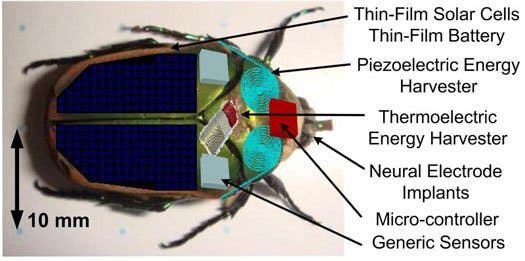After a devastating earthquake, most often buildings will crumble trapping people inside its ruins. Search and rescue teams work effortsly in such situation, employing both high tech solutions like heat-seeking or the simple, yet ever effective trained dogs to save people. Twenty four hours after a disaster though, the chances of a person trapped alive in the rubble to survive exponentially decrease, it’s imperative thus to get them out as soon as possible – you have to find them first. But who or what can get through those crammed spaces and signal the presence of life? Researchers from University of Michigan believe an army of cyborg insects might spearhead rescue operations in the future.
A common theme I see in spy movies, the bad sort granted, is a sort of mechanical, robot thingy insect that buzzes around, camouflaged as an unsuspected fly which actually feed back video or audio footage. The researchers at hand didn’t replicate this idea, but instead decided to harvest the energy of insects fitted with miniature technology instead of engineering them from scrap.
RELATED: Cyborg-rats with artificial cerebellums – first step ahead the age of the borg
“Through energy scavenging, we could potentially power cameras, microphones and other sensors and communications equipment that an insect could carry aboard a tiny backpack,” said Professor Khalil Najafi, the chair of electrical and computer engineering, at University of Michigan . “We could then send these ‘bugged’ bugs into dangerous or enclosed environments where we would not want humans to go.”
Kinetic energy from a bug’s wings for example could be used to power the various life-detecting sensors mounted on them. It’s an extremely difficult task to create such a device, but the scientists managed to overcome this with great inguinity. A spiral piezoelectric generator was designed to maximize the power output by employing a compliant structure in a limited area, which transforms the wing movements of the insect into electricity, in turn used to charge the battery.
It’s a highly interesting prospect, one which funnels hope for a more efficient life-saving process. And maybe super spy drones.
science daily










